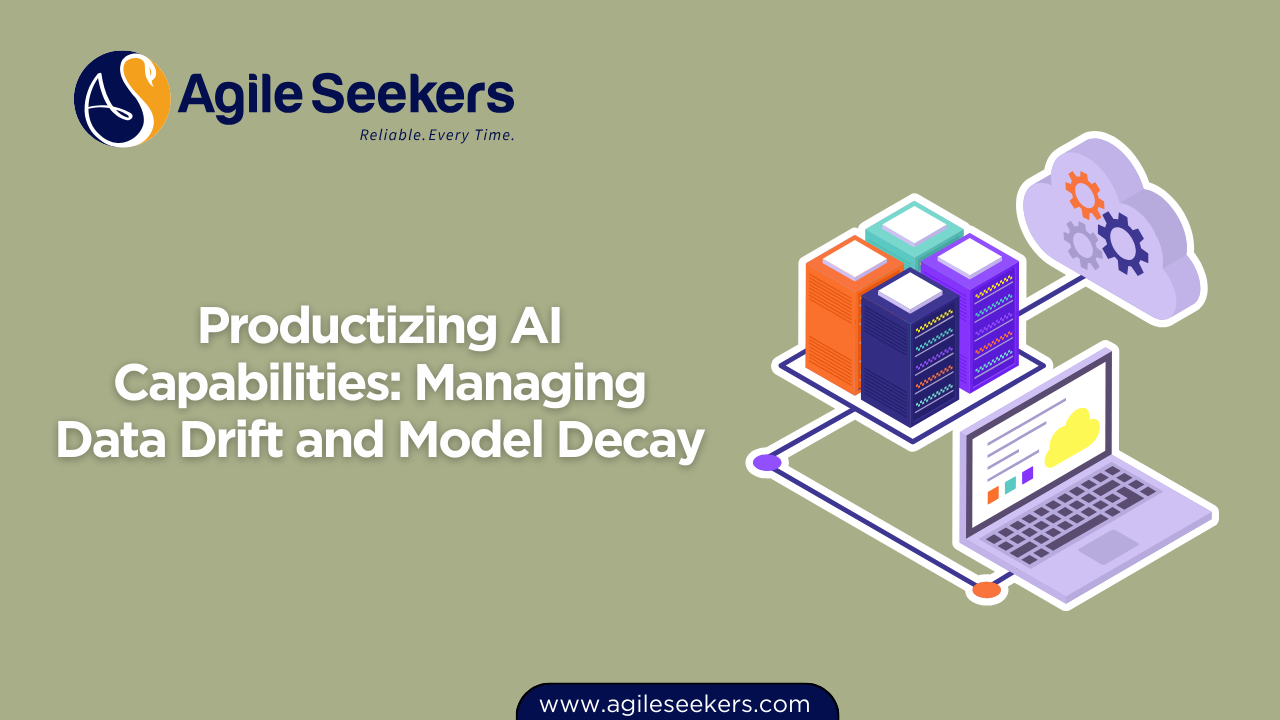Productizing AI Capabilities: Managing Data Drift and Model Decay

Bringing artificial intelligence into production is more than deploying a trained model. It involves treating AI as a product—one that requires consistent upkeep, reliability, and measurable business value. Yet, many teams fail to account for what happens after deployment. Two critical challenges that surface during post-deployment stages are data drift and model decay. Ignoring them can lead to silent failures, eroded performance, and poor user trust.
This post breaks down the causes and consequences of drift and decay, outlines practical strategies to detect and mitigate them, and highlights how strong project management professional certification principles support successful AI productization.
Understanding the Problem: Data Drift and Model Decay
What Is Data Drift?
Data drift refers to changes in the statistical properties of input data over time. Your model was trained on a certain distribution—any deviation from this baseline can reduce its predictive accuracy. This drift might be gradual (e.g., seasonality), sudden (e.g., market disruptions), or cyclical (e.g., school year vs. summer vacation behavior).
What Is Model Decay?
Model decay occurs when a model’s performance deteriorates over time. While drift can cause decay, other factors—like model staleness, overfitting, or ignored edge cases—can also lead to this erosion. Decay is particularly dangerous when it happens quietly, with stakeholders continuing to trust outputs that are no longer valid.
Why Drift and Decay Are Hard to Spot in AI Products
- Lack of real-time ground truth: Many AI models—especially in healthcare, fraud detection, or credit scoring—don’t get instant feedback about whether predictions were right or wrong.
- High complexity of inputs: Models working with images, sensor data, or unstructured text may see subtle changes that are difficult to quantify.
- Overconfidence in automation: Once a model is deployed and running, teams may shift focus elsewhere, assuming the system is working unless it breaks spectacularly.
This is where treating AI as a product rather than a one-time model becomes essential. SAFe POPM training teaches practitioners how to manage such evolving systems, aligning them with business goals through continuous feedback loops and prioritized backlogs.
Common Sources of Drift and Decay in Production AI
| Source | Impact | Example |
|---|---|---|
| External events | Model becomes outdated | COVID-19 changed ecommerce and travel behaviors drastically |
| Feature distribution shift | Inputs no longer match training data | New user devices or platforms causing resolution changes in vision models |
| Labeling inconsistency | Training signal weakens | Outsourced labeling team changes annotation guidelines mid-project |
| Seasonal effects | Short-term performance drop | Holiday-related spikes in sentiment or buying patterns |
Early Detection: Setting Up Monitoring Systems
To catch drift before it degrades the user experience, set up monitoring tools that track:
- Feature distribution changes: Tools like Evidently AI or Fiddler can compare live inputs against training data distributions.
- Model confidence scores: Unexpected changes in confidence (too low or too high) may indicate input distribution shifts.
- Performance benchmarks: Regularly validate against hold-out datasets and human-reviewed cases to catch accuracy dips.
This data-driven vigilance resembles the kind of measurement discipline taught in pmp training, where baseline metrics are tracked and reviewed throughout a project’s life cycle—not just at launch.
Mitigation Strategies: Responding to Drift and Decay
1. Scheduled Model Retraining
Plan retraining cycles based on data freshness, seasonal patterns, or usage spikes. Automate pipelines to minimize manual overhead and reduce regression risk.
2. Online Learning or Incremental Updates
Where applicable, incorporate feedback from users or human-in-the-loop validation to enable near-real-time updates to the model.
3. Data Versioning and Rollbacks
Use tools like DVC, MLflow, or LakeFS to track data changes and link models back to exact training conditions. This is key for debugging and auditability.
4. Ensemble or Shadow Models
Deploy alternate models in parallel to detect divergence or validate outputs before fully switching to new versions.
5. Feature Store Hygiene
Keep your feature store clean, documented, and version-controlled. Avoid silent feature drift caused by upstream pipeline changes or renamed columns.
Cross-Functional Ownership for Long-Term AI Stability
Managing data drift and model decay isn’t just the job of data scientists. Product managers, platform engineers, QA leads, and domain experts need to co-own the monitoring and maintenance of AI capabilities. This requires:
- Establishing ownership handoffs post-deployment
- Building retraining triggers into business processes
- Adding model health KPIs to product dashboards
- Using agile prioritization techniques from SAFe Product Owner/Manager certification to manage AI feature evolution
Framing AI as a Long-Term Product
Teams that succeed in scaling AI are the ones that stop treating models as projects and start viewing them as evolving products. Like any product, AI needs telemetry, customer feedback loops, lifecycle planning, and clear prioritization frameworks.
This mindset aligns with both SAFe POPM certification principles—especially around adaptive product strategy—and pmp certification training, which emphasizes structured risk management and quality control.
Conclusion: Sustaining AI Performance Over Time
Managing data drift and model decay is about putting discipline and process around post-deployment AI. It requires integrating monitoring, retraining, and stakeholder communication into the normal rhythm of your product development. AI products don’t break dramatically; they degrade quietly. If you don’t watch them, your users will be the first to notice.
Whether you’re a product leader building AI-powered features or a project manager overseeing delivery, sharpening your strategy with the right certifications and frameworks—such as SAFe POPM training or Project Management Professional certification—can prepare you for the challenges of long-term AI maintenance.
Also read - Managing Experiment Fatigue in Continuous Product Testing
Also see - Designing Incident Playbooks for Customer-Facing Product Downtime




















